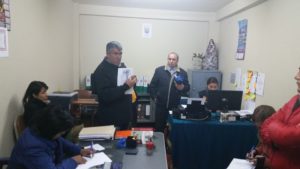By a regular contributor:
Our concern is why so many died–about a third of the town of Yarnell with only 645 residents have deceased at this time in only 8 years. The ratio of deaths per 100,000 in the US for 2013 was 732:100000. That then for 645 resident should mean that there should have been a ratio of 4.7 deaths in 645 residents. If you multiply that by 8 you come up with only 37 people should have died there in 8 years. Folks, withing the first couple years there were already about a hundred deaths. By 2015 the second fire called the Tenderfoot fire required more retardant dumping to add to the hundreds of thousands of gallons that had colored the town during the Yarnell killer fire of 2013.
Looking at it at another way–there were over the 8 years 6-7 times as many deaths than should have been at Yarnell. That does not include the illness caused by the retardant–and as a long time fireman told me–he could only look at the photo of Dr. Anderson a few seconds without turning away. It is traumatic just viewing the photo. Of course there are plenty that will refute the idea that retardant has had anything to do with the deaths and sickness at Yarnell. However they can not deny that fish are instantly killed from even small amounts of the retardant, nor the fact that EPA has already spent more than 140 million dollars cleaning up phosphate dumps from abandoned mine dump seepage into waters in Florida. The ground waters there are being contaminated with the phosphates–the main ingredient of your retardant.
But our major concern are the hidden ingredients under trade secret laws. I suspect they are Fluorocarbons–PFC’s–banned in most European countries. They have many uses and are excellent fire retardant chemicals–used in plastics, treating cloths for fire retardant safety, fire retardant foams, plastics and numerous other uses. They are organic compounds soluable in water and cumulative in human organic systems. Maybe they will make you immune to Covid 19 since they are so deadly but they also are known to thicken your blood platelets so cholesterol sticks to your arteries and can eventually cause heart failure.
Have you not noticed how much more firemen suffer heart attacks than the general population. Many of the deaths at Yarnell, including my own some months after the first dumping of 2013, were due to heart attack–plugged arteries. The retardant seems to have a fertilizing effect on cancer as well.
Carbon is of course an inert element but Florine is one of the most deadly substances on earth. The pilots that haul it in barrels for water treatment plants will tell you that they can not even touch the barrels without special gloves and hazmat equipment. To do so requires a report and immediate medical attention. The barrels are bright yellow with the black skull and bones warning labels everywhere on them.
Most of these chemicals were Monsanto originals. If you want to see their long criminal history of chemical dispersion and death and disease causal–it is there. But of course they pay fines as a part of business expense–there is not conscience, nor does anyone get prosecuted for the death and sickness they cause. They obviously care less about lives, but that is the corporate attitude. Monsanto sold out to another corporation and that corporation sold out to an Israeli outfit that now produces much of the world’s retardant poisons.
If you want to know the great injustice, not only to citizens whose yards and homes are laden with chemical retardant during fires, it is that these chemicals in as much as 15% of the retardant are kept secret under trade secret laws. Neither the citizen nor the fire fighter knows what he is being contaminated with. A doctor can know but can not publicize it.
Now if you do not understand the gravity of the situation–California waters are now in many areas so contaminated with phosphates and fluorocarbons from retardant run off that whole aquifers are becoming useless for human hydration. EPA is now spending millions there to clean up lands –especially around airports where firemen practice and use much retardant.
The government surely knows this–and sending a fireman or wild land fire fighter into these dangerous chemicals is a guarantee that his life will be shortened just as so many citizens had at Yarnell. I do not know how compensation is due the fire men subjected to these dangerous chemicals, but certainly there needs to be an adjustment in pay and education to the real truth of what they are facing.
As I see it and cowboy commons sense says don’t get trapped in a canyon above a raging fire near and keep your self away from the retardant chemicals if you value your health.

